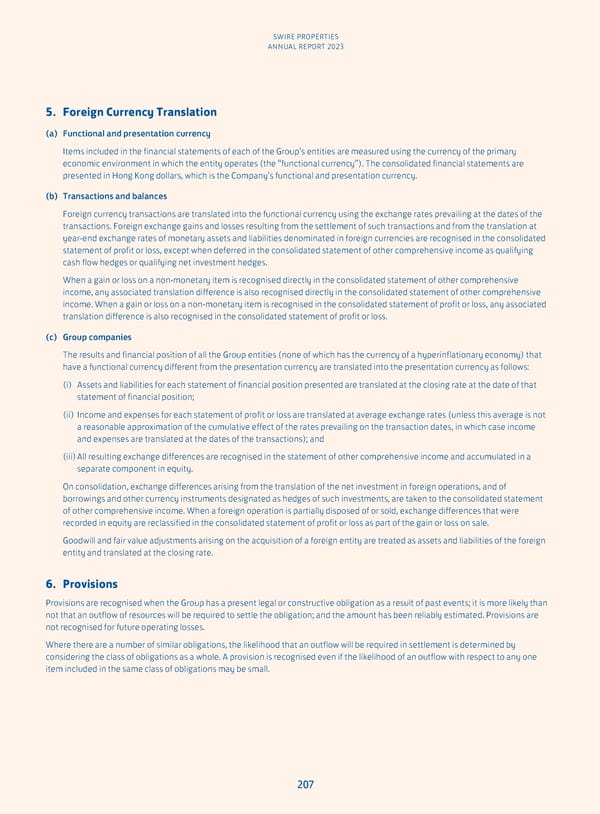SWIRE PROPERTIES ANNUAL REPORT 2023 5. Foreign Currency Translation (a) Functional and presentation currency Items included in the financial statements of each of the Group’s entities are measured using the currency of the primary economic environment in which the entity operates (the “functional currency”). The consolidated financial statements are presented in Hong Kong dollars, which is the Company’s functional and presentation currency. (b) Transactions and balances Foreign currency transactions are translated into the functional currency using the exchange rates prevailing at the dates of the transactions. Foreign exchange gains and losses resulting from the settlement of such transactions and from the translation at year-end exchange rates of monetary assets and liabilities denominated in foreign currencies are recognised in the consolidated statement of profit or loss, except when deferred in the consolidated statement of other comprehensive income as qualifying cash flow hedges or qualifying net investment hedges. When a gain or loss on a non-monetary item is recognised directly in the consolidated statement of other comprehensive income, any associated translation difference is also recognised directly in the consolidated statement of other comprehensive income. When a gain or loss on a non-monetary item is recognised in the consolidated statement of profit or loss, any associated translation difference is also recognised in the consolidated statement of profit or loss. (c) Group companies The results and financial position of all the Group entities (none of which has the currency of a hyperinflationary economy) that have a functional currency different from the presentation currency are translated into the presentation currency as follows: (i) Assets and liabilities for each statement of financial position presented are translated at the closing rate at the date of that statement of financial position; (ii) Income and expenses for each statement of profit or loss are translated at average exchange rates (unless this average is not a reasonable approximation of the cumulative effect of the rates prevailing on the transaction dates, in which case income and expenses are translated at the dates of the transactions); and (iii) All resulting exchange differences are recognised in the statement of other comprehensive income and accumulated in a separate component in equity. On consolidation, exchange differences arising from the translation of the net investment in foreign operations, and of borrowings and other currency instruments designated as hedges of such investments, are taken to the consolidated statement of other comprehensive income. When a foreign operation is partially disposed of or sold, exchange differences that were recorded in equity are reclassified in the consolidated statement of profit or loss as part of the gain or loss on sale. Goodwill and fair value adjustments arising on the acquisition of a foreign entity are treated as assets and liabilities of the foreign entity and translated at the closing rate. 6. Provisions Provisions are recognised when the Group has a present legal or constructive obligation as a result of past events; it is more likely than not that an outflow of resources will be required to settle the obligation; and the amount has been reliably estimated. Provisions are not recognised for future operating losses. Where there are a number of similar obligations, the likelihood that an outflow will be required in settlement is determined by considering the class of obligations as a whole. A provision is recognised even if the likelihood of an outflow with respect to any one item included in the same class of obligations may be small. 207
 Annual Report 2023 Page 208 Page 210
Annual Report 2023 Page 208 Page 210